China
In 1998 a friend and I decided to tackle the Silk Road, so we met in Hong Kong, took the ferry to Guangzhou and then rode a local river ferry upriver into China. From there we wandered for two months from southeastern China to the far western outpost of Kashgar and up into the Tibetan highlands. Time in Kashgar led to the underlying premise of Karen L. McKee’s suspense novel Ashes and Light and part of that novel takes place in the Kashgar market.
There was so much to love and hate on that journey it still confounds me when people ask what I thought of China. You tell me.
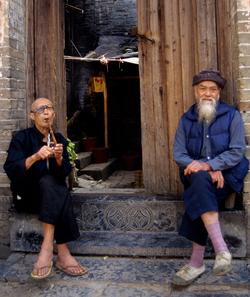
The Chinese Esthetic: Xi’an, Muezzin and the Terra Cotta warriors
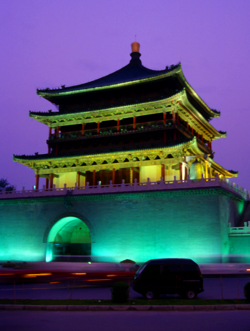
Along the highway that led from the ancient, yet modern, city of Xi’an towards the Terra Cotta warriors stood numerous representations of the new Chinese view of the world – at least that was how it seemed. The Eiffel Tower, the Pyramids, the Sphinx each stood in their own theme-park type setting at about 50% scale, and we wondered how the Chinese laid claim to those wonders of the world and how they could actually stand to put them cheek by jowl with the wonder that was to come at the tomb of the terra cotta warriors. But then, perhaps we misjudged the wonder of the terra cotta warriors.
The tout driving our bus dropped us off about half a mile away from the actual site with a rousing hawk and spit like we’d seen so annoyingly-often in China. As a result, we were forced to hike up the hill to a huge huddle of buildings encircled by tourists buses and vendors selling water, bright tapestry vests and caps, post cards, and bronze copies of the warriors – more kitsch. But in the midst of all the hawkers an elderly man and his wife sold true treasure: luscious, crimson strawberries. They allowed us to taste before buying – wonderful burst of flavor across my parched tongue – and asked me what they were called in English. In exchange he told me they are called Gao mei (phonetic). What a wonderful blessing for the day.
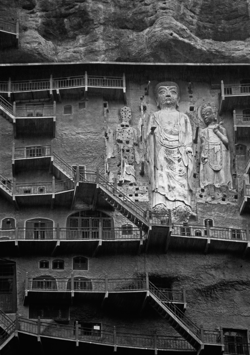
Inside the madhouse that was the terra cotta warriors site, a huge, excavated pit exposed the ranks of upright and repaired warriors, but the farther back we went along the pit the light dimmed and the state of the statues and excavation became less complete. Shattered bodies, the same pale yellow as the yellow loess soil, rose like ghosts up from the carnage of battle. At the rear, severed hooves and heads and hands littered the pit floor. Plastic tarps were draped to protect the archeological work in progress, but they seemed more like shrouds. The scene reminded me of the carnage after the battle of Agincourt in Kenneth Brannagh’s Henry V.
Back in the city of Xi’an we went looking for the Muslim quarter and the old mosque of the city’s ethnic Hui population which we’d previously sought in vain. With the help of information from an old Australian couple, we wandered down a narrow lane filled with vendors selling pseudo-antiques as well as shadow puppets and primitive, brightly-colored, ‘farmer paintings’. The mosque sat just off the curving lane behind a brick wall with ornate Islamic designs where people hung their song bird cages in the late afternoon sun.
The northeast gate put us along the north wall where carved tortoises supported carved stone stellae. In front, stood a 17th century gate with ornate, oriental roofs. Potted trees and palm plants and huge blue basins complete with goggle-eyed goldfish completed the peace of the place. The old wooden minaret stood three tiers tall with layers of azure tiled roof like an old Chinese temple.
A place for sitting and contemplating the falling sun and the heavy dark furniture inlaid with mother of pearl that filled other shadowed pavilions.
At about 5:30, men began to file through the cool evening air into the mosque. Most were older men, of the Muslim Hui ethnic minority. They wore pristine shirts and small skull caps as they hurried to prayer. In the hushed quiet we marveled at the difference in this place – a holy place – a place of sanctity after the capitalist terra cotta warrior site and the madhouse of Xi’an. We both felt the mosque was a highlight of the city – one we wished we’d found sooner to escape the madness of the May 5th Countrywide holiday.
As we sat there enjoying the peace, the muezzin entered the minaret and picked up the microphone. I leaned over to my friend and said that I actually liked the sound of the call to prayer. At that moment, amplified over the loudspeaker, came the resplendent hawk and spit of the muezzin before he began his call.
Aah, China. Ridiculous and Sublime.
May 98
Kashgar – The China That is Not – Yet
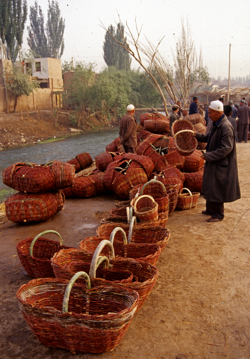
In the early morning, standing on the bridge over the small river that cuts the Sunday Market grounds from the heap of Kashgar town, I was struck by the fact that the market I was about to enter had existed since the time of the Silk Road caravans. Sitting in the far west of China, Kashgar was more like being in central Asia, than in a Chinese town, though the Chinese were coming with the railway they were building and they were tearing down the old parts of Kashgar town.
In the river below me, old women washed straw brooms the color of old honey and young men wash baskets the color of old blood. Age and old ways were still practiced in the apothecary shop with its display of dried frogs and snakes. A couple of local Uigher men arrived early to the market – people drive their horses and walk many miles for this weekly affair – and the men got to discussing my height and one came up to compare himself to me. We all laughed when I could see over the top of his hat.
In the animal market a woman sold bowls of thick yoghurt and a lad sold what look like bagels and tea. We bought two bowls and bagels and share them while sitting on a tarp under a tree as the market sets up. Acres of it.
In one area flocks of sheep mill and were lined up in regimented ranks for sheering. In another area tough-looking dish-nosed , fine-boned horses stood tethered to their carts or saddled amid the scent of manure and sweet hay. Some had bells on their harness and tasseled bridles that hung over their wide nostrils. All are shod – some not well – and though I didn’t see it, apparently the market often hosted horse races. Beyond the horses, donkeys and mules brayed and a separate section helds cattle and camels.
Outside of the livestock sections where the unwary could be mowed down
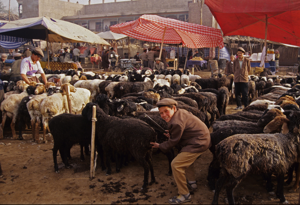
by a herd of sheep (who knew they were dangerous), the market filled with barbers, knife sharpeners, kiosks of millinery – shelves of prayer hats, wonderful sheep sheerling, mink-edged tall brown hats, and unbelievably soft lynx hats, all true Uigher hats.
There were aisles of fruit and tomatoes and red-stained eggs, muslim tea and heaps of spice and dried walnut, apricots, raisons, almonds, figs and dates. We bought some of all of it to make our own travel mix for the long bus journeys ahead. Old men in long black coats and tall black boots and Uigher hats sold dried chilies and bales of fresh onions. We looked at carpets worn beyond belief but sold as antiques.
Later we met with an Uigher friend we had made, who dressed in a pancake hat and wore a tweed sports jacket that still proudly bore the maker’s label on the sleeve. We sat on the pink-clay rooftop of the house where he lived, careful of the areas of the roof that he said became soft in the rain. He made black tea for us and explained the undercurrent of the Uigher people.
They were not happy being part of China. The young Uigher don’t leave for Chinese ways and were not attracted by the money. They resented that they were no longer allowed to have their calls to prayer from their central mosque. They resented the influx of Chinese and the tearing down of their ancient towns in the name of progress. No important posts in western China were held by Uigher, and no large businesses were owned by them. Still they hoped that things would change and be able to go back to the old ways.
We sipped tea as the sun set and the sky turned deepest blue and the charcoal cook-fires of Kashgar trailed smoke above the poplars and into the sky. Our friend said to us that the hope of the Uigher people was that in 10 or 20 years the resources of this part of China – the resources that have brought the Chinese and would only bring more once the railway is complete – would be depleted and the Chinese would leave.
He hoped. He thought.
And I didn’t have the honesty to tell him the truth.
May 1998
Lamusa and the sky
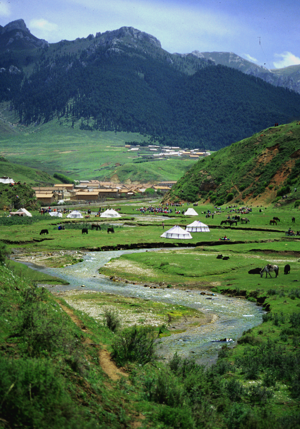
Lamusa sits high in the mountains of what was the northern plateau of Tibet and is now part of the Chinese province of Qinghai. It is a small Tibetan village and cluster of monasteries surrounded by mountains, green meadows, the low, black tents of nomadic Tibetans and herds of yak, though now the Tibetans have been joined by Hui Chinese sent by the Han master-race to colonize. We planned to climb one of the mountain ridges to the Monastery of Saita Gumba.
The sun was beginning its long fall towards the west and the monastery’s golden tiles gleamed above us, set off by the dark green of the trees and the deep blue sky. Long, black and white traditional draperies hung from the monastery’s rear courtyard.
We passed the main monastery and headed higher up the almost deserted hillside. In other parts of the valley, monks gathered small groups of children to teach them Buddhists lessons that the Chinese had ‘forbidden’ by shutting down the Buddhist school. We kept going, aiming for a path that seemed to lead toward the highest monastery building and there we met a monk on the path.
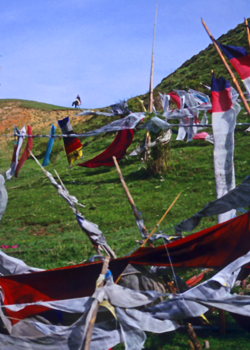
He led us far up the slopes southwest of town, until he announced we were standing in Sichuan Province. Above us, yellow prayer flags sputtered in the wind while below us the entire town was laid out with small smoke spires rising along the glittering thread of the river. Southwestward lays a broad saddle of land and high hills that surround the Lamusa river valley. Uphill, beyond the saddle, stood another, larger stand of prayer flags – unbeknownst to us the monk had brought us to see the sky burial grounds.
The monk stayed behind, seated beside the lower prayer flags as we made our way across ground filled with dips and hummocks, trips to the unwary. Strewn amongst the sparse grass were bits of clothing: a shoe insole, torn trousers, a bit of stained shroud, a shirt. We kept walking, but noticed off to the east Tibetan riders laboring up the steep slope. In the distance snow-capped mountains stood topped with clouds and the wind blews fierce into our faces and tore at the flags.
Bits of bone dotted the ground, a piece of pelvis, a bit of femur. Nothing else, really, to tell you where you were. They could have been bits of animal bone – until you got close and saw the palate sans teeth, the jaw, the fine curve of a rib strewn amongst the clothing. And over it all are the flags whipped by the wind that would always chill at this altitude. Small white flags and banners of bright colors and teepees of flags flew prayers over tattered clothing.
Sky burials entail taking a body out to the elements. The body is broken up and left to be given back to the world. We wondered what could reduce these bodies to such small pieces given we’d not seen any sign of animals and kites the size of eagles are the largest birds we’ve seen. We found out later that there were vultures that had left behind their dark feathers amidst the grass, pale lichen, buttercups and small purple daisy of the highlands.
As we picked our way through small gravestones, a rider cames up onto the ridge above us and then swept down to say hello- or perhaps to make sure we didn’t disturb the dead. He was young – no more than a boy, really, in Tibetan robes and astride a grey horse like a ghost out of long ago.
So we left, trudging down the hill, the chill wind pushing us away until we came to the waiting monk and the other prayer flags. There the wind stopped, as if we aren’t wanted on that windy hillside and weren’t supposed to be there.
But beneath the lower group of prayer flags the sun warmed me through.
June 98










One Reply to “China”